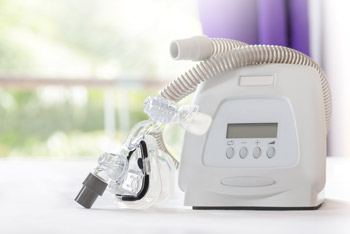The Road to Better Rest: Understanding and Treating Obstructive Sleep Apnea
by Riley Huffman
October 2025
Getting enough restful sleep each night is as important as eating well and staying active. According to a 2020 public health report, almost one-third of adults in Dickey County don't get enough sleep each night, a problem caused by many things. Some people stay up too late on purpose. Others stay up because of work schedules or family responsibilities. But sometimes the cause is medical. One of the most common medical reasons for poor sleep is obstructive sleep apnea.
 Obstructive sleep apnea
(OSA) – the condition where breathing during
sleep is blocked or even stops – is like
traffic on a busy rural highway. When the road is clear,
cars move easily down the two-lane road – just
like air flows freely into the lungs during normal
breathing. Sometimes, the road narrows because of a
slow-moving tractor or farm equipment. Traffic slows
down. Cars build up. This is like snoring, when air
struggles to pass through a partly blocked airway. At
other times, the road becomes completely blocked, like
when a fallen tree or stalled vehicle stops all traffic.
No cars can get through. Like a blocked road, in OSA, the
airway might fully close and breathing stops. Eventually,
a back-up mechanism in the brain reacts, waking the
sleeper just enough to automatically open the airway.
This start-stop pattern of breathing happens many times
throughout the night. When breathing stops, oxygen levels
drop, and sleep is not restful.
Obstructive sleep apnea
(OSA) – the condition where breathing during
sleep is blocked or even stops – is like
traffic on a busy rural highway. When the road is clear,
cars move easily down the two-lane road – just
like air flows freely into the lungs during normal
breathing. Sometimes, the road narrows because of a
slow-moving tractor or farm equipment. Traffic slows
down. Cars build up. This is like snoring, when air
struggles to pass through a partly blocked airway. At
other times, the road becomes completely blocked, like
when a fallen tree or stalled vehicle stops all traffic.
No cars can get through. Like a blocked road, in OSA, the
airway might fully close and breathing stops. Eventually,
a back-up mechanism in the brain reacts, waking the
sleeper just enough to automatically open the airway.
This start-stop pattern of breathing happens many times
throughout the night. When breathing stops, oxygen levels
drop, and sleep is not restful.
When this cycle of start-stop breathing happens night after night, someone with OSA might be told they snore – and loudly. Anyone watching an OSA-er sleep might even notice they stop breathing or suddenly gasp for air. An OSA-er might feel very tired during the day, even after what seems like a full night of sleep. Any of these should signal there's sleep disruption that could use some attention.
Testing for OSA starts with a sleep study, a test that is likened to checking a busy highway's traffic flow. This might take place overnight in a special sleep center, or sometimes at home using a small device that tracks breathing and oxygen levels. The results can show how often breathing stops and how oxygen levels change, results that help guide treatment decisions.
Of several OSA treatment options, first is CPAP therapy, which stands for continuous positive airway pressure. A CPAP machine gently blows air through a mask, so that the airway does not collapse, and breathing remains smooth. Another treatment option is wearing a special mouthpiece during sleep. This device moves the lower jaw forward slightly, which can help keep the throat open. For some people, weight loss can also improve symptoms if extra weight around the neck or throat is part of the problem.
For people with OSA, treatment often improves energy and lessens daytime sleepiness. For some, even their mood is improved. Experts have discovered that other health conditions like high blood pressure, certain heart problems, and diabetes can be avoided or improved if someone's OSA is treated.
Sleep problems may go unnoticed – or even seem like a normal part of life. However, anyone who snores loudly, wakes up tired, or feels exhausted every day should not ignore those signs. A conversation with a healthcare provider can open the road to better rest.
About the Author
 Riley Huffman is a fourth-year medical student at
the University of North Dakota School of Medicine &
Health Sciences. As a participant in medical and
community experiences offered in Oakes, she chose to
participate in the Targeted Rural Health Education (TRHE)
program. The program focuses on teaching student doctors
the importance of rural newspapers as a way to share
health information with their rural community. The
information is not for diagnosis or treatment and should
not be used in place of previous medical advice provided
by a licensed healthcare provider.
Riley Huffman is a fourth-year medical student at
the University of North Dakota School of Medicine &
Health Sciences. As a participant in medical and
community experiences offered in Oakes, she chose to
participate in the Targeted Rural Health Education (TRHE)
program. The program focuses on teaching student doctors
the importance of rural newspapers as a way to share
health information with their rural community. The
information is not for diagnosis or treatment and should
not be used in place of previous medical advice provided
by a licensed healthcare provider.
